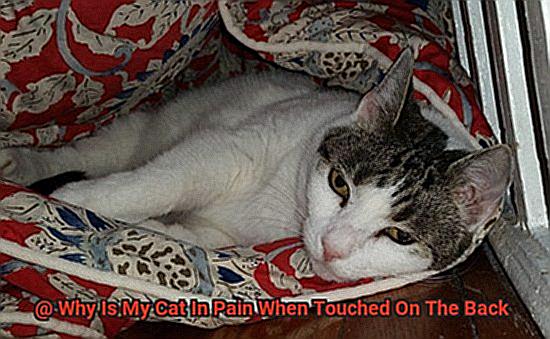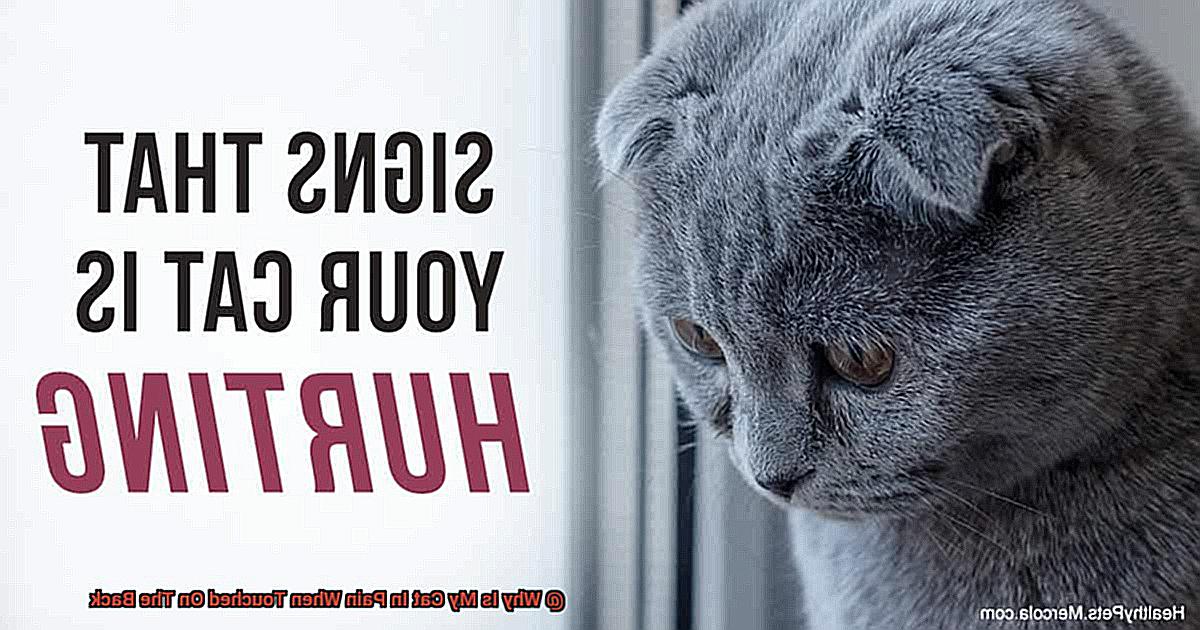Have you ever noticed that your cat is in pain when touched on the back? It’s a frightening and confusing experience for both you and your pet.
Unfortunately, it’s a common problem among cats with various potential causes.
We’ll explore why your cat may be in pain when touched on the back, what some of these causes are, and how medications can help alleviate their pain.
It could be due to an injury or infection that has gone undetected.
Or it could be something as simple as arthritis or muscle pain from over-grooming.
Allergies, worms, or even fear or anxiety may also be at play.
If you suspect your cat is in pain when touched on the back, don’t hesitate to bring them to the hospital right away. Your veterinarian will likely perform a physical exam and run tests such as blood work or x-rays to find out what’s causing your cat’s pain.
If they have a diagnosis, they can show you how to properly care for your pet and reduce their discomfort.
With prompt attention and care, you’ll be able to ensure that your beloved fur baby gets better soon.

What Are the Signs and Symptoms of Feline Hyperesthesia?
Have you ever noticed your cat becoming suddenly agitated and meowing loudly when touched on the back? This could be a sign of feline hyperesthesia, a condition that causes cats to become hypersensitive to touch.
Knowing the signs and symptoms can help you identify this disorder in your own cat.
The most common symptom of feline hyperesthesia is when your cat becomes alert to touch on its back, resulting in agitation and loud meowing as if in pain.
Other signs of this condition include restlessness and pacing around the house, excessive grooming or licking of their fur, dilated pupils when touched on the back, and sudden jerky movements when touched on the back.
Your cat may also display other behaviors such as twitching, biting, scratching at the skin, vocalizing, running away from touch, aggressive behavior towards people or other animals in the household, hiding or trembling.
Feline hyperesthesia is similar to a storm brewing inside your cat’s body; it’s an eerie sensation that can take over their behavior and cause them to be ill.
What Causes Feline Hyperesthesia?
Cats may be suffering from feline hyperesthesia.
This condition can be difficult to diagnose as the exact cause is often unknown.
However, there are several potential explanations for it.
Medical Condition
An underlying medical condition, such as an infection, injury, or neurological disorder, could be the cause of feline hyperesthesia.
Stress and anxiety
Stress and anxiety can also lead to heightened sensitivity in cats and can be triggered by environmental factors like loud noises or changes in the home environment.

Allergies and parasites

Allergies and parasites may also play a role in this condition.
If your cat is showing signs of pain when touched on their back or any other area of their body, it’s essential for pet owners to seek veterinary help.
Fortunately, feline hyperesthesia can often be managed with medications, lifestyle changes, and environmental modifications.
Diagnosing Feline Hyperesthesia in Cats
Diagnosing feline hyperesthesia in cats can be tricky; the signs are often similar to other illnesses, making it difficult to pinpoint the exact cause.
To ensure an accurate diagnosis, veterinarians must use a variety of diagnostic tests, including blood tests, urine analysis, X-rays, and ultrasounds.

Even if cats have feline hyperesthesia, they may not show any visible signs of distress when touched on the back.
That’s why vets rely heavily on a detailed history of the cat’s behavior – any sudden changes or increased sensitivity could indicate that something is wrong.
It’s like putting together pieces of a puzzle; vets need all the information they need to properly diagnose feline hyperesthesia in cats.
How to Treat Feline Hyperesthesia
Feline hyperesthesia is a condition that can cause cats to experience pain when touched on the back.
To ensure your cat’s comfort and wellbeing, it’s important to have the right treatment plan in place.
This guide will provide you with all the information you need to know about treating feline hyperesthesia.
Medications
Medications are often prescribed by veterinarians to help reduce anxiety and fear in cats suffering from hyperesthesia.
These medications may include anti-anxiety drugs, anticonvulsants, tricyclic antidepressants, gabapentin, or amitriptyline.
Make sure to follow your vet’s instructions when giving your cat any medication.
Behavior Modification Strategies
Behavior modification strategies such as clicker training can be used to teach cats new behaviors and help them learn how to cope with their triggers.
This type of exercise can help reduce anxiety levels in the cat and prevent future episodes of hyperesthesia.
Environmental Changes
Making environmental changes such as providing more hiding places, reducing noise levels, and avoiding sudden movements can all help reduce stress levels in cats suffering from hyperesthesia.
Additionally, providing an enriched environment with plenty of playtime and stimulation can keep your cat calm and relaxed.
Physical Therapy and Massage Therapy
In some cases, physical therapy or massage therapy may be beneficial for cats suffering from hyperesthesia in order to relieve pain and discomfort in the affected area.
Depending on your individual needs, your veterinarian may recommend a particular type of physical therapy or massage technique for your cat.
Surgery
In rare situations where other therapies are ineffective, surgery may be required if there is an underlying medical condition causing pain or discomfort in the back area of the cat.
Before making any decisions about surgery for your pet, make sure to discuss all options with your veterinarian.
Treating feline hyperesthesia requires a combination of medications, behavior modification strategies, environmental changes, physical therapy/massage therapy, and possibly surgery depending on the situation.
Preventing Feline Hyperesthesia
Feline hyperesthesia is a medical disorder that can cause cats to become overly sensitive to touch, sound, and sight.
As pet owners, it’s essential to take preventive measures to ensure your cat stays healthy and happy.
Think of your cat’s environment as a garden – one that needs to be nurtured for it to thrive. Provide plenty of opportunities for play and exercise with scratching posts and toys.
Make sure your cat has a safe place to retreat if they feel overwhelmed or overstimulated by their environment.
Regular vet checkups are recommended, as they can help identify any underlying health issues that may be contributing to the disorder.
Be vigilant for any changes in your cat’s behavior that could be signs of feline hyperesthesia.
It’s like having an early warning system in place – if you spot anything unusual, contact your veterinarian right away.
Common Misconceptions About Feline Hyperesthesia

Feline Hyperesthesia often comes with a cloud of misconceptions and misunderstanding.
Let’s clear the air and explore the common myths and truths about this mysterious condition.
Contrary to popular belief, Feline Hyperesthesia is not rare – it can affect cats of all ages and breeds.
Furthermore, cats with Feline Hyperesthesia are not dangerous, but may be more prone to biting or scratching if they feel threatened or scared.
Although there is no “cure” for Feline Hyperesthesia, it can be managed with the right treatment plan including medications, environmental changes, and behavioral modifications.
Lastly, any cat can develop this condition regardless of weight or declawing status – even though overweight cats and those that have been declawed may be more susceptible.
Feline Hyperesthesia can be daunting at first, but don’t worry – you are not alone in this journey.
When to See a Vet for Your Cat’s Pain
It can be difficult to tell when your beloved feline is in pain, but if you notice them screaming when touched on the back, it’s time to take them to the vet.
Your veterinarian will be able to diagnose the source of the pain and provide treatment options.
Common causes of back pain in cats include injury, infection, arthritis, or a condition known as feline hyperesthesia syndrome.
Pain medications and lifestyle changes such as increased exercise or weight loss may also be recommended.
It is also important to keep an eye on your cat’s behavior and activity level.
If they stop eating or become lethargic, it could be a sign that they are in pain and need medical attention.
Consider it like a car that needs to be changed; if you don’t take care of the issue now, it will only get worse over time.
So if your cat is exhibiting signs of discomfort, don’t wait any longer – bring them to the vet for a checkup.
With professional care, you can help ensure your furry friend stays healthy and happy for many years to come.
Final Thoughts on Feline Hyperesthesia
For cats with feline hyperesthesia, it can feel like a storm is brewing inside.
This condition can be physically painful and distressing, but there are steps you can take to help your cat lead a happy and healthy life.
It’s important to be aware of the signs of feline hyperesthesia, such as excessive grooming, twitching or trembling, vocalizing, and aggression.
If you spot any of these behaviors in your cat, please seek veterinary help immediately.
The key to managing this condition is reducing stress and anxiety levels for your cat.
This may involve providing more playtime and environmental enrichment activities or using anti-anxiety medications or antidepressants.
However, each cat responds differently to treatments so it’s essential to consult with your veterinarian first.
Caring for a feline hyperesthesia cat requires patience and understanding from both the owner and the veterinarian.
With the right treatment plan in place, cats with this condition can lead long lives free of pain and discomfort.
Conclusion
Feline hyperesthesia, a frightening and confusing condition for both cats and their owners, can be identified by signs such as excessive grooming, twitching, trembling, vocalization, or aggression.
If you notice any of these behaviors in your cat, seek veterinary assistance immediately.
Fortunately, feline hyperesthesia can often be treated with medications, lifestyle changes, environmental changes and massage therapy.
Knowing what triggers your cat’s allergies is key to helping them live a happier and healthier life.
Providing plenty of playtime and exercise opportunities can also reduce anxiety in cats with this disorder.
Treating feline hyperesthesia requires patience and knowledge from both the owner and the vet.







